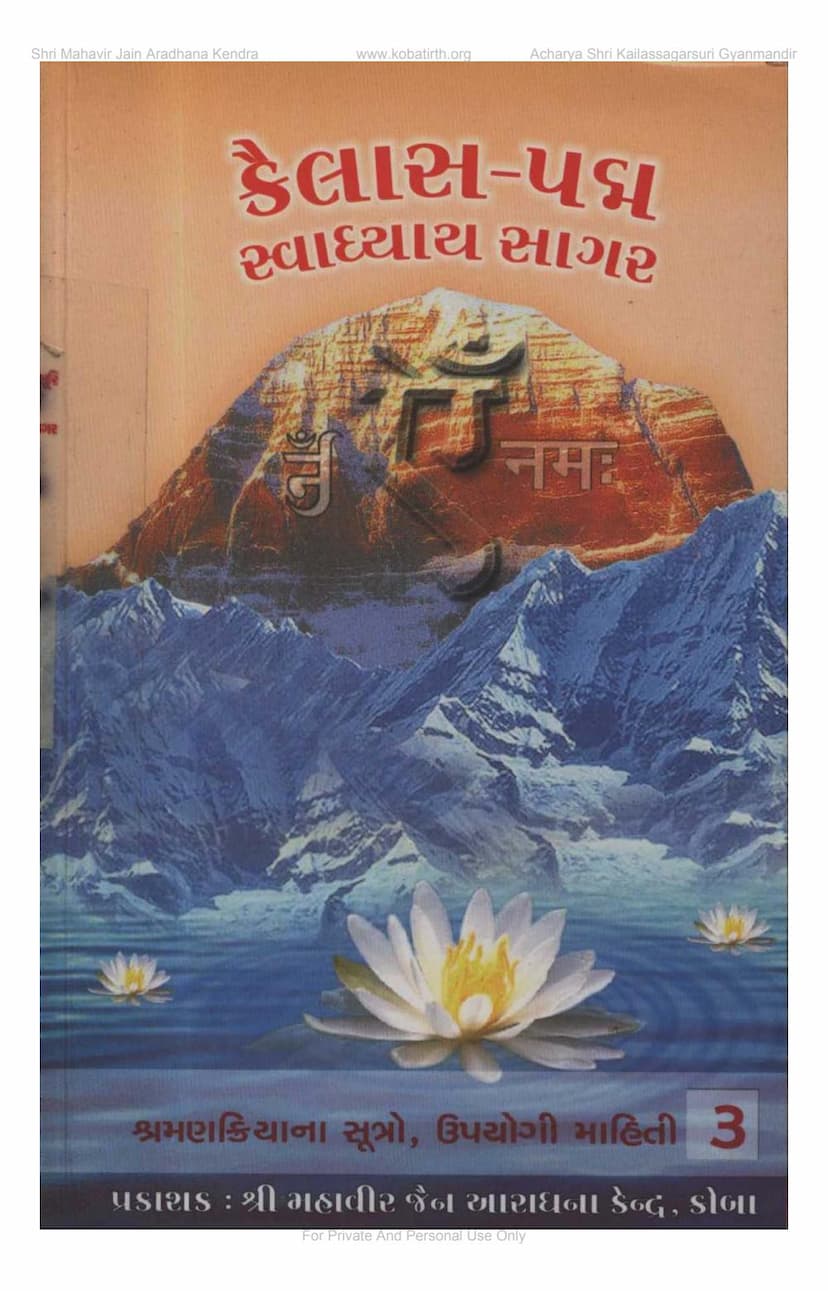Kailaspadma Swadhyayasagara Part 3
Added to library: September 2, 2025

Summary
Here's a comprehensive summary of the provided Jain text, "Kailaspadma Swadhyayasagara Part 3," based on the text content and the provided pages:
Book Title: Kailaspadma Swadhyayasagara Part 3 Author: Munishri Padmaratnasagarji Publisher: Shri Mahavir Jain Aradhana Kendra, Koba Catalog Link: https://jainqq.org/explore/008480/1
Overall Summary:
"Kailaspadma Swadhyayasagara Part 3" is a foundational Jain text published by the Shri Mahavir Jain Aradhana Kendra in Koba, Gujarat. This particular volume, compiled by Munishri Padmaratnasagarji, focuses on Shraman Kriya (the practices and rituals of Jain ascetics) and useful information (Upayogi Mahiti). It serves as a practical guide and compendium of essential knowledge for Jain monks, nuns, and sincere devotees aiming for spiritual progress.
The text is dedicated to Acharya Shri Kailassagarsuri Gyanmandir and highlights the auspicious occasions of Acharya Shri Padmasagar Surishwarji's 52nd anniversary of renunciation (sanyam bhavan) and his 72nd birthday.
Key Content Areas:
The table of contents reveals a structured approach to various Jain practices and principles, including:
-
Core Jain Mantras and Prayers: Starting with the Namaskar Mahamantra, Karemi Bhante, Icchami Thami, and other essential recitations for daily spiritual practice.
-
Pratikraman (Confession and Recollection): Detailed procedures for Devsiki (daily), Ratriki (nightly), Pakshiki (fortnightly), Chauvisi (twenty-four Tirthankaras), Samvatsari (annual), and other forms of Pratikraman, including specific sections on ingress and egress from the avagraha (a consecrated space).
-
Ascetic Practices and Regulations:
- Pudilehana (Purification): Methods for purifying the muhapattti (mouth cloth), raja-haran (broom made of wool or hair), and other essential items.
- Porisi: Rituals related to periods of the day, including Santhara Porisi (a specific ritual related to the resting place).
- Gochari (Alms Gathering): Detailed lists of the 42 faults to be avoided while collecting alms and the 5 faults related to mandali (the gathering of ascetics for meals).
- Sthandil Shuddhi: The process of purifying the ground for religious practice.
- Tapa (Austere Practices): Mention of various Tapa procedures and their timings.
- Samayika and other Vows: Procedures for observing Samayika (equanimity practice), Pachchakkhan (vows), and understanding the time limits for various items (vastuno kal vigere).
- Guru-Disciple Interactions: Includes sections on Guru Vakya (Guru's command), acceptance of Guru's blessings, and question-answer sessions between disciples and Gurus.
- Conduct of Ascetics: Discussions on Sadhu Charya (ascetic conduct), Asvadhyaya (prohibitions on study), Sutak (periods of ritual impurity), and the four limbs of Chitta vata (control of mind).
- Rituals for the Deceased: Procedure for the passing away of an ascetic (Sadhu Kal Dharma Vidhi).
-
Detailed Explanation of Vows: The text elaborates on the five great vows (Pancha Mahavrata) and their associated Atichara (infringements or lapses), providing specific details for each vow, such as Pranaatipata Veraman (non-violence), Musaavada Veraman (truthfulness), Adinnaadana Veraman (non-stealing), Maitthuna Veraman (chastity), and Parigraha Veraman (non-possession). The explanations are extensive, detailing various aspects and classifications of each vow.
-
Sutras and Gathas: The text is rich with Sutras (aphorisms) and Gathas (verses) in Prakrit and Gujarati, which are central to Jain ritual and practice. Many sections, especially those related to Pratikraman and vows, are presented in a dialogical or instructional format.
-
Specific Rituals: Includes procedures for Chaitra Vandana (worship of shrines), Sajjhay (recitation of scriptures), and Pachchakkhan Parana (breaking of vows).
-
Timings and Conditions: Discusses the appropriate times for various activities, the conditions for using certain items (Vastuno Kal Vigere), and lists of prohibited or conditional items (Anahari).
-
Tabulated Information: The presence of tables, such as the "Anaaharee Upyog no Koshtak" (Table of Aharic items), suggests a systematic presentation of practical guidelines.
Emphasis on Clarity and Guidance:
The text is meticulously compiled and edited, with acknowledgments given to various monks and scholars for their contributions in research, correction, and guidance. The publisher's note expresses a long-held desire to make these sacred texts accessible and easy to use for ascetics and spiritual seekers, especially during their travels. The emphasis on patha shuddhi (accuracy of text) indicates a commitment to the authenticity and clarity of the teachings.
Target Audience:
This book is primarily intended for Jain ascetics (monks and nuns) who need to meticulously follow the prescribed rituals and regulations. It also serves as a valuable resource for laypeople seeking to understand the intricacies of Jain practices and deepen their spiritual knowledge.
In essence, "Kailaspadma Swadhyayasagara Part 3" is a vital manual for understanding and performing the core ritualistic and ethical practices within the Jain monastic tradition, offering detailed guidance on everything from daily observances to the detailed breakdown of vows and their infringements.